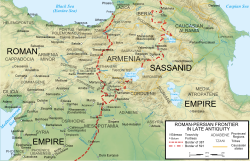Byzantine Armenia
Byzantine Armenia, sometimes known as Western Armenia,[1][2][3] is the name given to parts of the Kingdom of Armenia that became part of the Byzantine Empire (eastern Roman Empire). The size of the area changed multiple times through the course of history.
The Byzantine and Sassanid Empires divided Armenia in 387 and 428 AD. Western Armenia was part of Byzantine rule, whilst Eastern Armenia (Persianized Armenia) was part of the Sassanids. Even after the Bagratid Armenian Kingdom was created, parts of historic Armenia and Armenian-inhabited areas were still under Byzantine rule.
Byzantine Armenia Media
The "Calvary cross potent" standing on a number of steps was minted on solidus coins (also shows without the steps on tremissis coins) by various Byzantine emperors, mainly in the 7th century during the reign of Heraclian dynasty and after. Also similar or identical was used by the Lombard princes in Italy (see here).
References
- ↑ Rivoira, Giovanni Teresio (1918). Moslem Architecture: Its Origins and Development. Oxford University Press. p. 188.
- ↑ The Armenian Review, Volume 3. Boston: Hairenik Association. 1950. p. 25.
- ↑ Baumstark, Anton (2011). On the Historical Development of the Liturgy. Collegeville, Minnesota: Liturgical Press. p. 102. ISBN 9780814660966.

